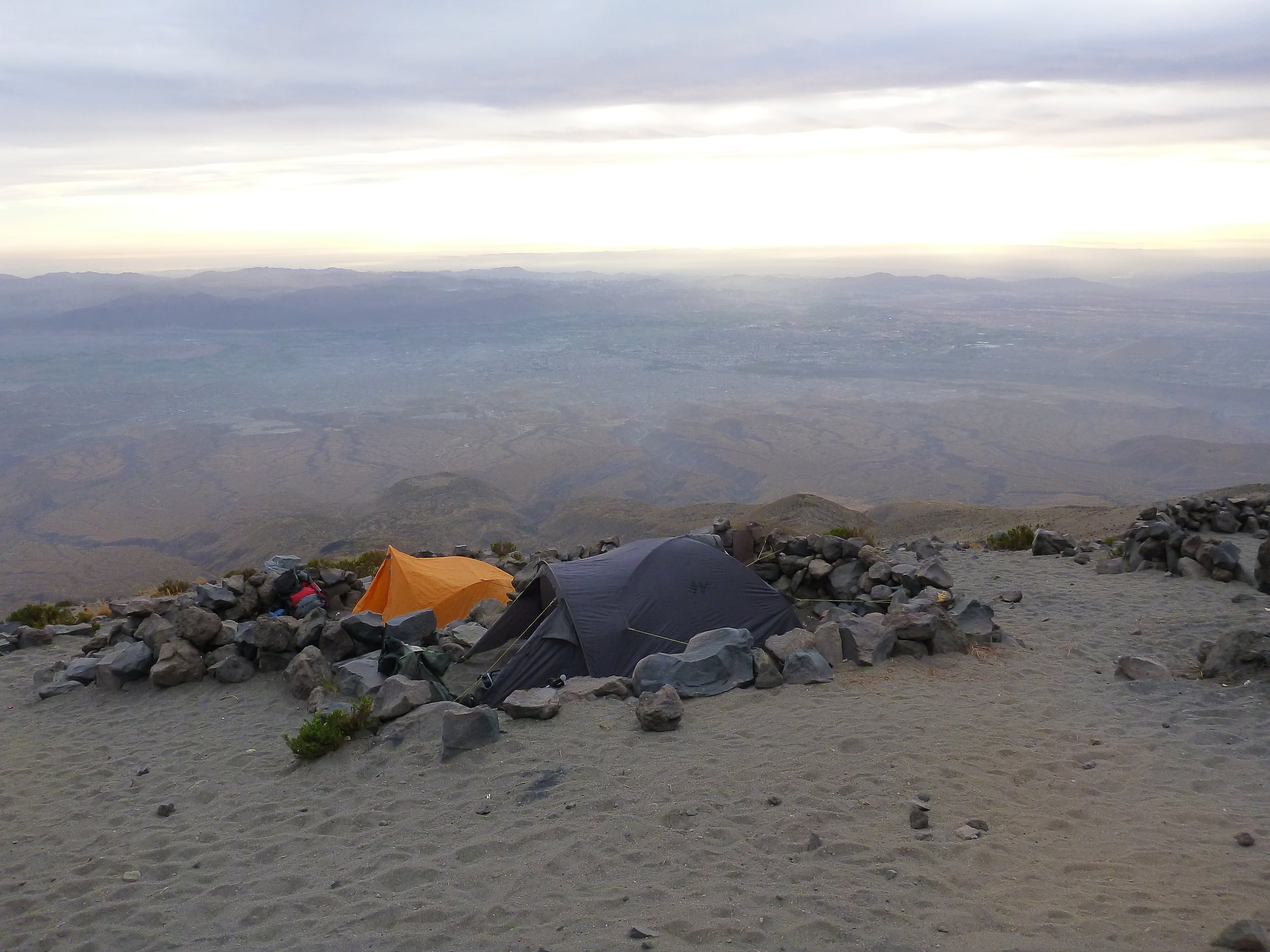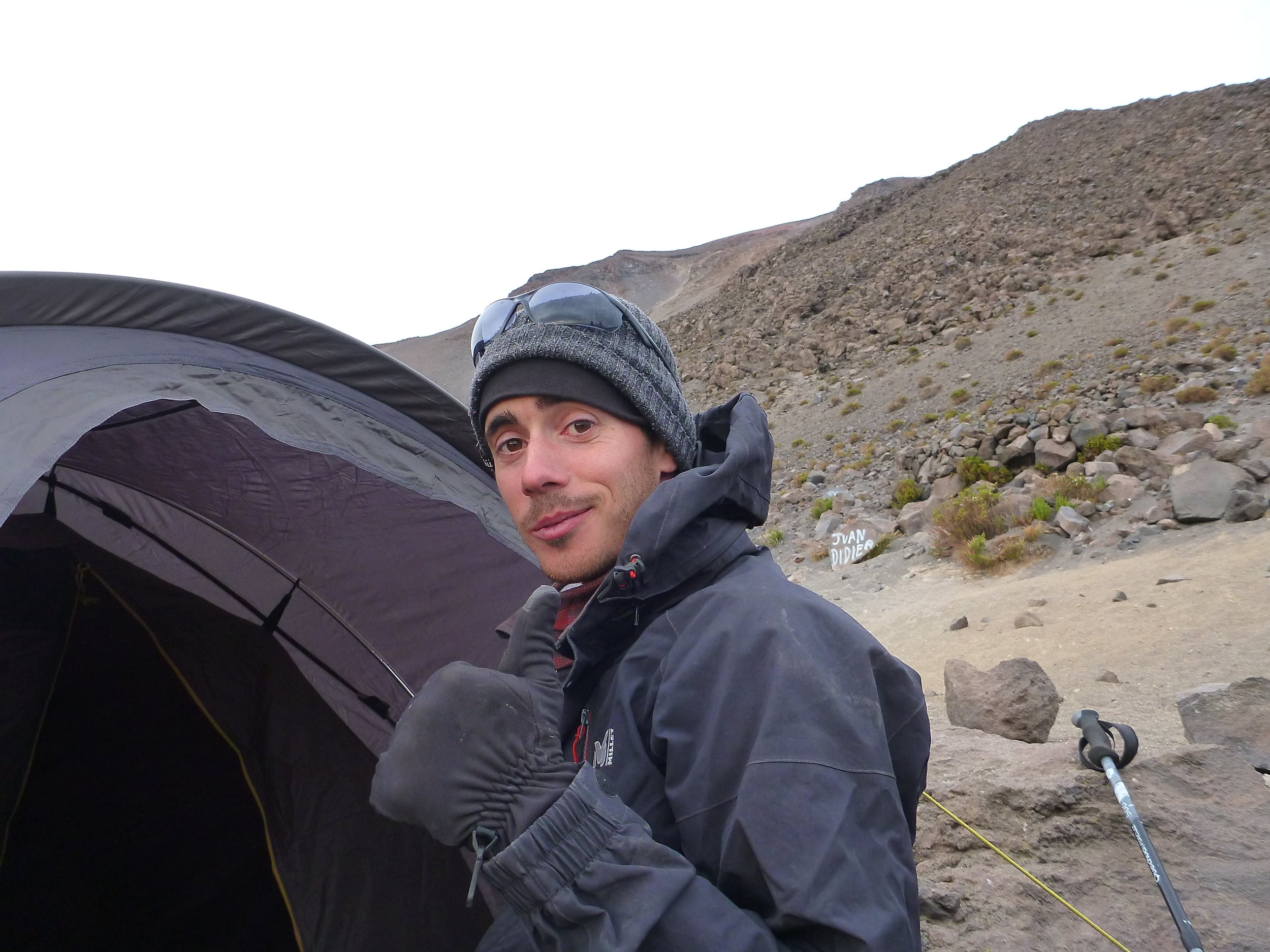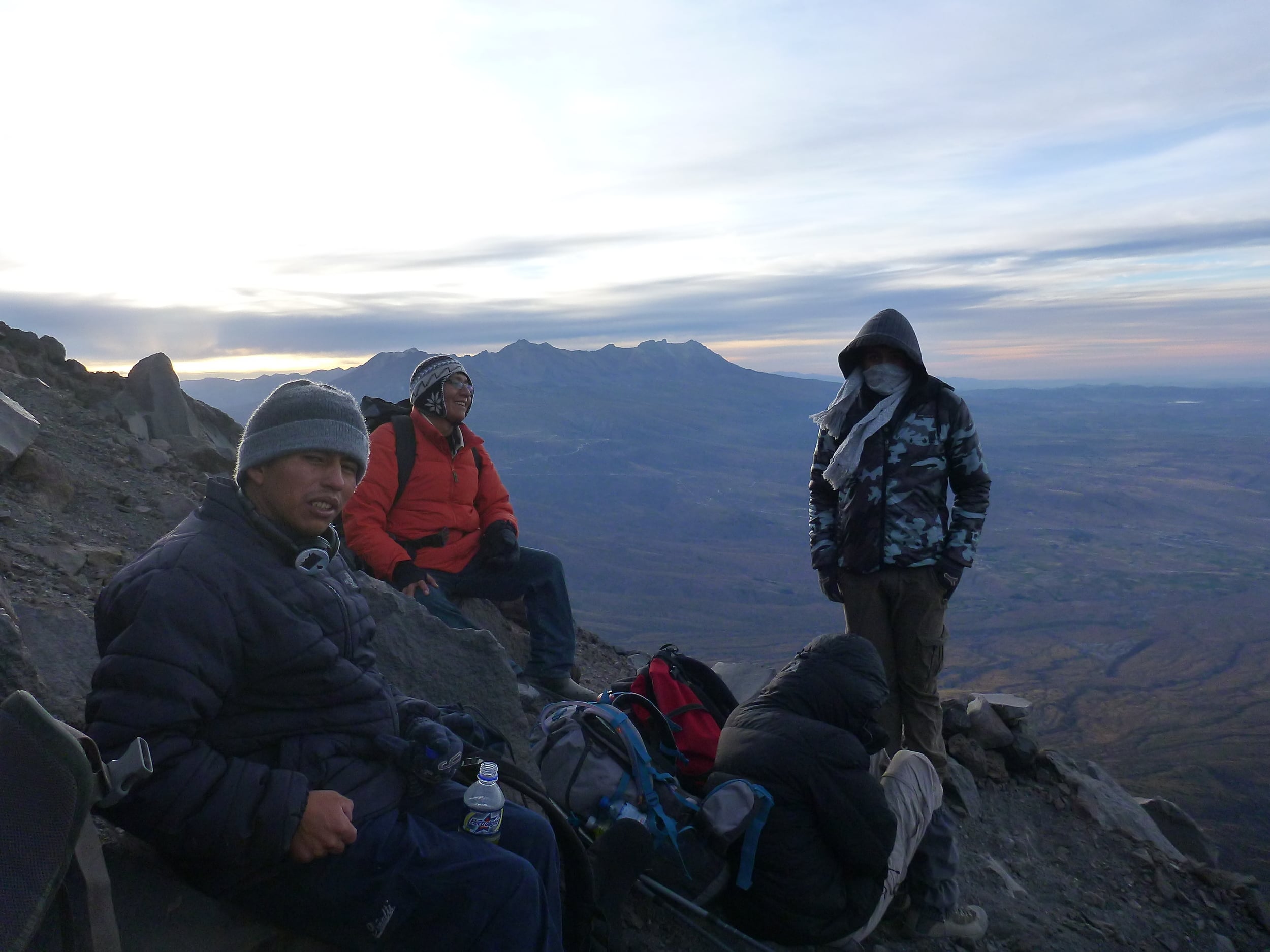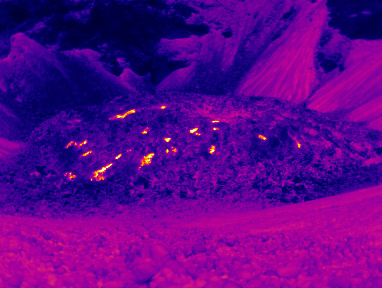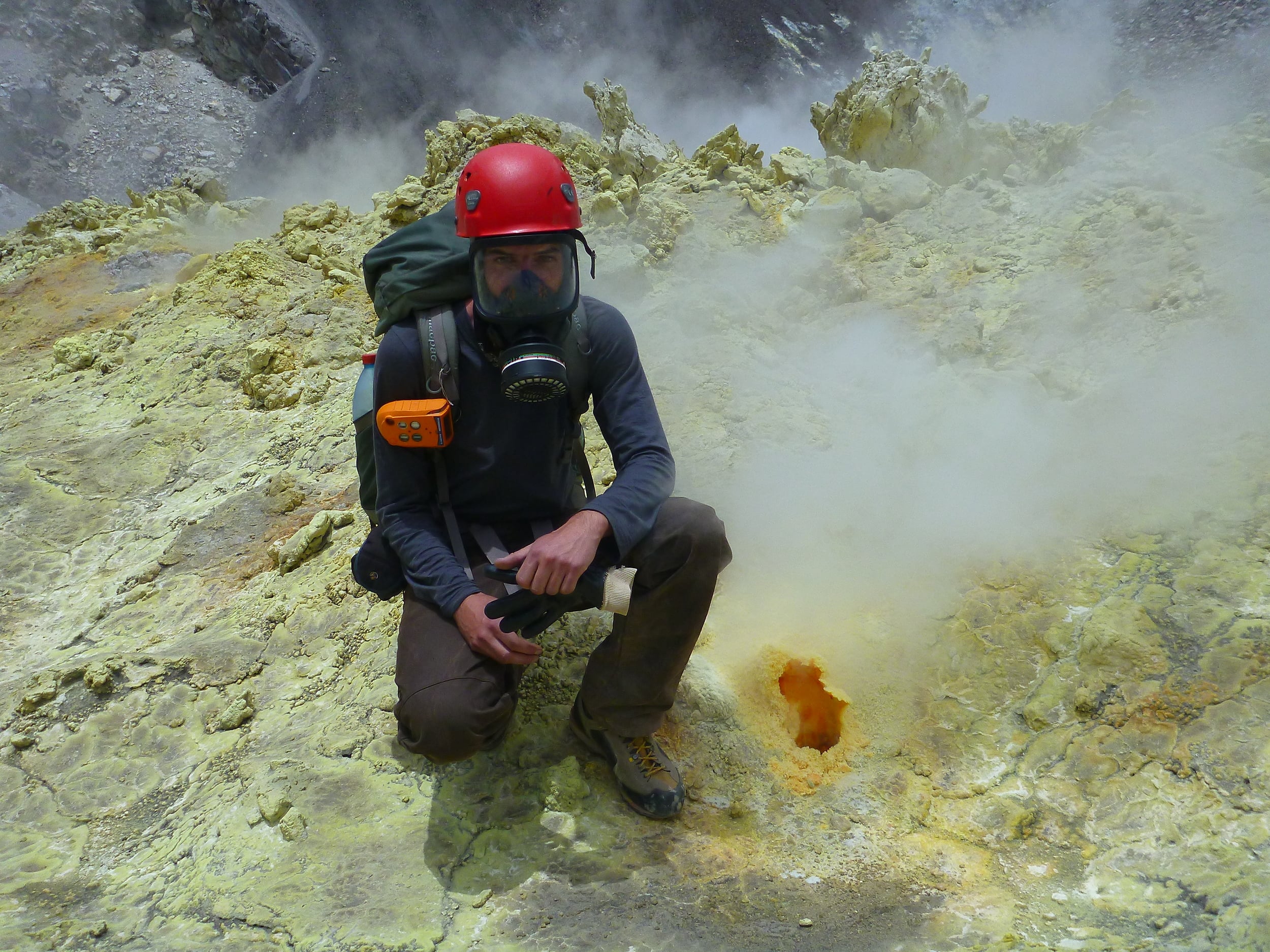Dominating the skyline of Arequipa, El Misti is a big volcano. Although slightly smaller than Sabancaya in absolute terms (i.e. height above sea level, 5822 m compared to 5976 m), the lower surrounding terrain of El Misti makes it look a lot more formidable. Indeed, our Peruvian colleagues at OVI warned us (repeatedly!) that El Misti was the harder of the two to climb. Having only just made it to the top of Sabancaya without losing our breakfast, it would be a lie to say that we were thrilled at the prospect of attempting something even harder. In the end, it was Yves and Nial who took up the challenge, and began stuffing camping gear into rucksacks.
The El Misti climb is a two day affair. The route (we took the Southern route) begins at around 3400 m and starts gaining height immediately. Approximately 4 hours of climbing gets you to the campsite at ~4600 m, a small set of terraced tent emplacements set into the steep scree slopes of the mountain. The second day involves a 3am start, followed by a further 6 hours of climbing to reach the summit.
In addition to Yves and Nial, there were five members of OVI and two guides climbing. Day one got off to slow start, with lots of shuttling of equipment and personnel to the trail head. In the end, we didn’t start climbing until well after lunchtime. Upward progress was pretty slow due to the amount of equipment we were all carrying and by the time we reached the campsite there were only a few hours to spare before dark. Based on Aaron’s advice, we had opted to carry takeaway pizzas for dinner rather than bring a stove and try to cook anything. So, with the tent set up, we relaxed in the fading light and tucked into a hearty meal of cold four-cheese and spicy-meat deliciousness. I have to say that this is the best thing I have ever eaten in the mountains. Dehy, energy-gel, pasta and all those other foods that you read about in mountaineering books are rubbish. What your body needs after a strenuous, high altitude workout, is a big greasy slice of cold pizza. I cannot stress this point enough.
As the sun dropped, so too did the temperature. Despite the fantastic views of nearby Pikchu Pikchu volcano turned deep pink in the sunset, and the twinkling streetlights of Arequipa far below us, we didn’t waste any time in getting into our nice warm sleeping bags. Even with the altitude, the cold, and the day spent carrying heavy things uphill, we felt pretty good, and the concerns that we had harbored about the climb rapidly drifted away. At 3 am the next morning however, the attrition started.
The group set off trudging slowly upwards in the darkness, with a collection of headtorches, iPhones and a Maglight gaffer-taped to a walking pole, illuminating our way. As dawn arrived and the distant silhouette of Ubinas volcano gradually revealed itself on the horizon, we found ourselves with a problem. We could now see the top of El Misti, and it was a long way away. This was not a huge morale booster, and neither was the fact that despite leaving all the camping gear at the campsite, our rucksacks did not seem any lighter. Taking some solace in the fact that our Peruvian colleagues were not finding the climb easy either, we pushed on, the pace getting ever slower.
A little over an hour later, the rest of the group reached the top. This called for a celebration, so we all lay down and went to sleep for half an hour. This was followed by the rest of the pizza. By this time, the stragglers in the group had caught up and we turned our attention to the task at hand. The OVI group planned to take some GPS measurements around the rim of the inner crater and to take some gas measurements from the fumaroles there. We wanted to take measurements of the gases emanating from the lava dome at the bottom of the inner crater. So, donning gas masks and helmets, Nial and Edison (one of the guides), headed over to the edge of the inner crater, passing by the site where six Inca mummies were discovered in 1998.
Lava dome in the El Misti crater. Photo: Pablo Masias Alvarez
The inner crater is around 200 m deep, with mostly vertical sides. However, at one point there is a steep scree slope that can be descended relatively safely without the need for ropes. The bottom of the crater is occupied almost entirely by a jagged lava dome, stained yellow in patches by sulphur deposits from the numerous gas vents in its surface. It is an impressive site. Our first descent attempt ended at a cliff, forcing us to back-track up the slope to find another route. It rapidly became evident that whilst descending the crater was easy, climbing back out again was going to be non-trivial. The levels of gas in the crater were extremely high, saturating our Crowcon GasPro detector almost immediately and requiring a change of gas mask filter after only a short period. We had heard stories from OVI that several years ago a volcanologist had suffered chemical burns to his respiratory system after saturating his gas mask filter in the El Misti crater, so we were well prepared, with spare filters close to hand. However, the masks exacerbated the breathing difficulties caused by the altitude and condensation from the plume made it hard to see anything. Combined with the burning heat of the gases, this made for very unpleasant working conditions.
After an hour of collecting samples, running filter packs and performing a traverse of the lava dome with the multiGas instrument we were satisfied and started heading home. Our earlier assessment proved to be correct. The route that had taken only a few minutes to descend took us over an hour and a half to climb. The loose scree slid out from under our feet with every step, and clinging to the slope with hands and feet was the only way to make upwards progress. By the time we reached the top, the OVI team had finished their measurements too, and, keen to return to a more sensible altitude, we started our descent straight away. Coming down is always the easy bit, and this is especially true for El Misti. A huge sandy slope stretches most of the way down the volcano, and by running down this we were back at the trail-head in just a few hours. Not long later we were tucking into a large plate of Chifa (Peruvian-Chinese food), and sleepily celebrating another successful volcano ascent. It was really good to go to bed that night.
